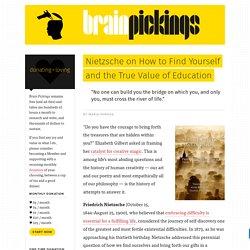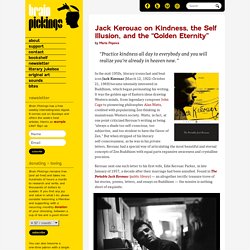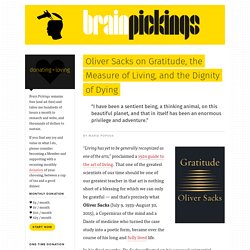

Nietzsche on How to Find Yourself and the True Value of Education. “Do you have the courage to bring forth the treasures that are hidden within you?”

Elizabeth Gilbert asked in framing her catalyst for creative magic. This is among life’s most abiding questions and the history of human creativity — our art and our poetry and most empathically all of our philosophy — is the history of attempts to answer it. Friedrich Nietzsche (October 15, 1844–August 25, 1900), who believed that embracing difficulty is essential for a fulfilling life, considered the journey of self-discovery one of the greatest and most fertile existential difficulties.
In 1873, as he was approaching his thirtieth birthday, Nietzsche addressed this perennial question of how we find ourselves and bring forth our gifts in a beautiful essay titled Schopenhauer as Educator (public library), part of his Untimely Meditations. Nietzsche, translated here by Daniel Pellerin, writes: Any human being who does not wish to be part of the masses need only stop making things easy for himself.
Jack Kerouac on Kindness, the Self Illusion, and the “Golden Eternity” By Maria Popova “Practice kindness all day to everybody and you will realize you’re already in heaven now.”

In the mid-1950s, literary iconoclast and beat icon Jack Kerouac (March 12, 1922–October 21, 1969) became intensely interested in Buddhism, which began permeating his writing. It was the golden age of Eastern ideas drawing Western minds, from legendary composer John Cage to pioneering philosopher Alan Watts, credited with popularizing Zen thinking in mainstream Western society. Watts, in fact, at one point criticized Kerouac’s writing as being “always a shade too self-conscious, too subjective, and too strident to have the flavor of Zen.” But when stripped of his literary self-consciousness, as he was in his private letters, Kerouac had a special way of articulating the most beautiful and eternal concepts of Zen Buddhism with equal parts expansive awareness and crystalline precision. Portrait of Jack Kerouac by Robert Frank Kerouac writes: Donating = Loving Share on Tumblr.
Be Like Water: The Philosophy and Origin of Bruce Lee’s Famous Metaphor for Resilience. With his singular blend of physical prowess and metaphysical wisdom, coupled with his tragic untimely death, legendary Chinese-American martial artist, philosopher, and filmmaker Bruce Lee (November 27, 1940–July 20, 1973) is one of those rare cultural icons whose ethos and appeal remain timeless, attracting generation after generation of devotees. Inspired by the core principles of Wing Chun, the ancient Chinese conceptual martial art, which he learned from his only formal martial arts teacher, Yip Man, between the ages of thirteen and eighteen. When he left Hong Kong in 1959, Lee adapted Wing Chun into his own version, Jun Fan Gung Fu — literal translation: Bruce Lee’s Kung Fu — and popularized it in America.
In 1971, at the peak of his career, Lee starred in four episodes of the short-lived TV series Longstreet. Oliver Sacks on Gratitude, the Measure of Living, and the Dignity of Dying. By Maria Popova “Living has yet to be generally recognized as one of the arts,” proclaimed a 1924 guide to the art of living.

That one of the greatest scientists of our time should be one of our greatest teacher in that art is nothing short of a blessing for which we can only be grateful — and that’s precisely what Oliver Sacks (July 9, 1933–August 30, 2015), a Copernicus of the mind and a Dante of medicine who turned the case study into a poetic form, became over the course of his long and fully lived life. In his final months, Dr. Sacks reflected on his unusual existential adventure and his courageous dance with death in a series of lyrical New York Times essays, posthumously published in the slim yet enormously enchanting book Gratitude (public library), edited by his friend and assistant of thirty years, Kate Edgar, and his partner, the photographer Bill Hayes. Last night I dreamed about mercury — huge, shining globules of quicksilver rising and falling.